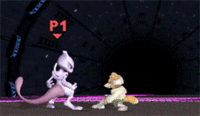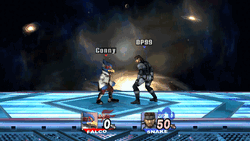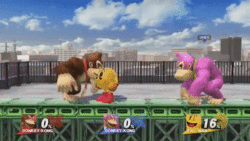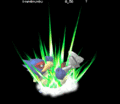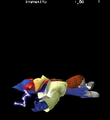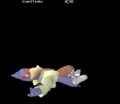Lock: Difference between revisions
(This term really isn't used to describe a move comboing into itself anymore) |
(rewrite and merge. phew. not done yet.) |
||
| Line 1: | Line 1: | ||
{{ArticleIcons|ssbb=y|ssb4=y}} | {{ArticleIcons|ssbm=y|ssbb=y||ssb4=y|unofficial=y}} | ||
{{ | [[File:Brawl-JabLock-Sonic.gif|thumb|{{SSBB|Sonic}} performing a [[neutral air]], [[footstool]] into a jab lock combo on {{SSBB|R.O.B.}}; then allowing a reset while simultaneously finishing with a [[forward smash]].]] | ||
[[File:jabreset.gif|thumb|{{SSBM|Mewtwo}} performing a [[down throw]] into jab reset then [[down smash]] on {{SSBM|Fox}}.]] | |||
A '''lock''' is a [[technique]] in ''[[Super Smash Bros. Brawl]]'' and ''[[Super Smash Bros. 4]]'' where a character can use low a [[knockback]] attacks to [[combo]] an opponent on the [[floor]] that is "prone"; aka "lying down". An animation of the victim briefly bouncing off the ground signifies a lock. Some moves that lock are fast enough to be repeated, while others cannot be repeated fast enough to keep the opponent in the locked position, or have knockback scaling that causes the opponent to be launched at higher percents. Some moves will move a character across the stage farther than others, causing less damage buildup overall. | |||
A '''lock''' is a [[technique]] in ''[[Super Smash Bros. Brawl]]'' and ''[[Super Smash Bros. 4]]'' where | |||
[[ | The '''reset''' was first introduced in ''[[Super Smash Bros. Melee]]'', and was then incorporated into the locking mechanic as the only [[floor recovery|wake-up]] option that can be used afterwards, allowing for a [[punish]] as the opponent stands up. The character will stand up in an identical animation of a standard neutral get-up, with [[intangibility]] frames at the beginning. | ||
Trying to perform a lock in ''Melee'' merely results in a reset, which the opponent can avoid altogether with [[ASDI]]. In ''Brawl'', a reset can occur only after locking has ceased which can result in [[zero-to-death combo]]s. In ''Smash 4'', it functions in the same way; but locking can now only be performed a maximum of three times before an automatic reset occurs<ref>https://twitter.com/EvenMatchup/status/509543588137402370</ref> (except in rare circumstances, see below). This can be considered a blend of the former locking and reset mechanics, respectively. [[Percent]]ages, [[weight]], and [[angle]]s are the most noteworthy properties in determining if a move will successfully lock or reset. Some moves only do so in very specific circumstances, while others almost always do. The listings below do not take any of these parameters into account, and only extremely character-specific or unwieldy locks are not to be listed. In every ''Smash'' game, including ''[[Smash 64]]'', an instant getup with a grounded [[flinch]] will occur in any low-knockback situation a lock or reset cannot. | |||
==How to perform== | |||
Starting a lock or reset is often the most difficult part, as most skilled players will [[tech]] or [[DI]] away before hitting the ground, and will also getup as soon as possible to avoid being locked. Surprise or fast attacks causing a character to fall quickly on the ground can work, as well as taking advantage of various situations in both ''Brawl'' and ''Smash 4'' in which a tech cannot be performed. For instance, [[Footstool Jump|Footstooling]] an airborne opponent will prevent them from being able to tech in any way while in [[tumble]], though the upwards momentum can cause the footstooler to be unable to follow up with a lock depending on their character. Holding down on the [[control stick]] to force a [[shorthop]] footstool aides in this. For some characters, it is possible to fast fall an aerial with lock properties to cause a single bounce, then follow up with a jab lock or reset. | |||
== | |||
Starting a lock is often the | |||
==Types of locks== | ==Types of locks== | ||
===Jab lock=== | {{cleanup}} | ||
The most common type of lock is the jab lock, which can be performed by multiple characters. As the name states, it is done by hitting a fallen character with a [[jab]], stepping forward, and hitting them again. The locked player can be moved to the end of the stage in ''Brawl'', where the active player generally hits them with a charged smash attack as they stand up. Generally it is done with only the first hit of the jab, but some characters can do it with the second hit as well. If one attacks too soon after each bounce, or use a move without lock properties, the character will snap to a standing position. In Smash 4, the jab lock only works up to three times. | ===[[Jab]] lock=== | ||
The most common type of lock is the '''jab lock''', which can be performed by multiple characters. As the name states, it is done by hitting a fallen character with a [[jab]], stepping forward, and hitting them again. The locked player can be moved to the end of the stage in ''Brawl'', where the active player generally hits them with a charged smash attack as they stand up. Generally it is done with only the first hit of the jab, but some characters can do it with the second hit as well. If one attacks too soon after each bounce, or use a move without lock properties, the character will snap to a standing position. In Smash 4, the jab lock only works up to three times. | |||
=== | ===[[Aerial]] move locks=== | ||
=== | ===[[Projectile]] lock=== | ||
[[File:Laser Lock Falco Brawl.gif|thumb|right|250px|{{SSBB|Falco}} performing a Laser Lock on {{SSBB|Snake}}.]] | [[File:Laser Lock Falco Brawl.gif|thumb|right|250px|{{SSBB|Falco}} performing a Laser Lock on {{SSBB|Snake}}.]] | ||
A commonly used lock is Falco's laser lock, which, unlike other locks, has enough range to hit and lock characters on level ground with Falco regardless of distance (assuming tournament legal maps). Larger stages like [[Bridge of Eldin]] can cause a character to move far enough away that Falco's lasers cannot reach them. There are many followup options that Falco can use, such as his [[BDACUS]]. The easiest and most effective way to set up a Laser Lock is to land a down throw or grounded down aerial and immediately [[buffer]] the first hit of Falco's jab. Falco cannot always follow up with a KO move because of distance, reducing the effectiveness of the laser lock to damage building only. It should also be noted that the laser lock only works at percentages equal to or exceeding 80% as Falco's moves will not cause a tumbling animation until said percentage. | A commonly used lock is Falco's laser lock, which, unlike other locks, has enough range to hit and lock characters on level ground with Falco regardless of distance (assuming tournament legal maps). Larger stages like [[Bridge of Eldin]] can cause a character to move far enough away that Falco's lasers cannot reach them. There are many followup options that Falco can use, such as his [[BDACUS]]. The easiest and most effective way to set up a Laser Lock is to land a down throw or grounded down aerial and immediately [[buffer]] the first hit of Falco's jab. Falco cannot always follow up with a KO move because of distance, reducing the effectiveness of the laser lock to damage building only. It should also be noted that the laser lock only works at percentages equal to or exceeding 80% as Falco's moves will not cause a tumbling animation until said percentage. | ||
| Line 31: | Line 28: | ||
Kirby using Falco's lasers will shoot them lower, allowing him to lock more characters than Falco can. | Kirby using Falco's lasers will shoot them lower, allowing him to lock more characters than Falco can. | ||
===Burial lock=== | ===[[Buried|Burial]] lock=== | ||
[[File:P-burial_lock.gif|thumb|right|250px|Two {{SSB4|Donkey Kong}}s performing an infinite lock on {{SSB4|Pac-Man}}]] | [[File:P-burial_lock.gif|thumb|right|250px|Two {{SSB4|Donkey Kong}}s performing an infinite lock on {{SSB4|Pac-Man}}]] | ||
Most moves with a burial effect are able to lock an opponent indefinitely (one notable example being {{SSB4|Villager}}'s down smash), giving the possibility of 0-death combos in team battles. It is important to note, however, that a lock cannot be started using a burying move, as the opponent will | Most moves with a burial [[effect]] are able to lock an opponent indefinitely past the three hit limit in ''Smash 4'' (one notable example being {{SSB4|Villager}}'s down smash), giving the possibility of 0-death combos in team battles. It is important to note, however, that a lock cannot be started using a burying move, as the opponent will reset before the lock is able to be continued. | ||
===Throw lock=== | ===[[Throw]] lock=== | ||
Many throws have a hitbox that collaterally damage nearby opponents. With proper positioning and timing, some of these throws are able to lock opponents. | Many throws have a hitbox that collaterally damage nearby opponents. With proper positioning and timing, some of these throws are able to lock other opponents. | ||
== | ===Other [[ground]]ed move locks=== | ||
Various [[special moves]], [[tilt]]s, and even weak parts of [[smash attack]]s can lock or reset opponents. | |||
===Jab locks=== | ==List of locking attacks== | ||
{{incomplete|lacks melee moves that can reset and many moves that can lock in rare situations. Also looks bad and needs re-formatted.}} | |||
===In ''[[Brawl]]''=== | |||
====Jab locks==== | |||
*{{SSBB|Donkey Kong}} | *{{SSBB|Donkey Kong}} | ||
*{{SSBB|Diddy Kong}} (appears only to work on | *{{SSBB|Diddy Kong}} (appears only to work on heavy characters like {{SSBB|Bowser}}, and can only lock at a certain part of the hitbox) | ||
*{{SSBB|Ike}} (only works on certain parts of the hitbox, and due to Ike's speed, small changes in the set-up can allow the victim to break out of it) | *{{SSBB|Ike}} (only works on certain parts of the hitbox, and due to Ike's speed, small changes in the set-up can allow the victim to break out of it) | ||
*{{SSBB|Jigglypuff}} (both first and second hits of jab) | *{{SSBB|Jigglypuff}} (both first and second hits of jab) | ||
| Line 59: | Line 60: | ||
*{{SSBB|Yoshi}} | *{{SSBB|Yoshi}} | ||
===Other locks=== | ====Other locks==== | ||
*{{SSBB|Diddy Kong}}: [[Peanut Popgun]] | *{{SSBB|Diddy Kong}}: [[Peanut Popgun]] | ||
*{{SSBB|Fox}}: neutral aerial, forward tilt | *{{SSBB|Fox}}: neutral aerial, forward tilt | ||
| Line 79: | Line 80: | ||
*{{SSBB|Zero Suit Samus}}: dash attack, forward tilt | *{{SSBB|Zero Suit Samus}}: dash attack, forward tilt | ||
==In ''SSB4''== | ===In ''SSB4''=== | ||
Jab Locks are still possible in ''SSB4''. However, in most cases, the opponent can only be hit three times before being freed. Moves that bury opponents are exceptions to this rule as most of them can lock infinitely. Moves that "lock" must hit the opponent within 25 frames of hitting the ground. | Jab Locks are still possible in ''SSB4''. However, in most cases, the opponent can only be hit three times before being freed. Moves that bury opponents are exceptions to this rule as most of them can lock infinitely. Moves that "lock" must hit the opponent within 25 frames of hitting the ground. | ||
*{{SSB4|Bayonetta}}: back aerial, down smash (first hit), [[Bullet Climax]] | *{{SSB4|Bayonetta}}: back aerial, down smash (first hit), [[Bullet Climax]] | ||
*{{SSB4|Bowser}}: down tilt, [[Whirling Fortress]] (excluding the last hit), down aerial, down throw, up throw | *{{SSB4|Bowser}}: down tilt, [[Whirling Fortress]] (excluding the last hit), down aerial, down throw, up throw | ||
| Line 154: | Line 154: | ||
*[https://gfycat.com/EvergreenWatchfulAstarte Falcon punch lock in Smash 4 on Bowser] | *[https://gfycat.com/EvergreenWatchfulAstarte Falcon punch lock in Smash 4 on Bowser] | ||
== | ==Gallery== | ||
<gallery> | |||
File:DownBoundU_Falco.gif|Falco's first animation during which he can be jab reset. | |||
File:DownWaitU_Falco.png|Falco's second animation during which he can be jab reset. | |||
File:DownStandU_Falco.gif|Falco's neutral get-up up animation that is forced in a jab reset. | |||
File:DownDamageU_Falco_jab_on_Falco_SDI_up_to_shine.gif|Using SDI and ASDI upwards to escape a jab reset. This looks notably similar to locking . | |||
</gallery> | |||
==References== | |||
{{reflist}} | |||
[[Category:Techniques (SSBM)]] | |||
[[Category:Techniques (SSBB)]] | [[Category:Techniques (SSBB)]] | ||
[[Category:Techniques (SSB4)]] | [[Category:Techniques (SSB4)]] | ||
[[Category:Advanced Techniques]] | [[Category:Advanced Techniques]] | ||
Revision as of 18:30, July 16, 2017
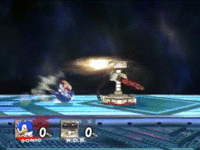
A lock is a technique in Super Smash Bros. Brawl and Super Smash Bros. 4 where a character can use low a knockback attacks to combo an opponent on the floor that is "prone"; aka "lying down". An animation of the victim briefly bouncing off the ground signifies a lock. Some moves that lock are fast enough to be repeated, while others cannot be repeated fast enough to keep the opponent in the locked position, or have knockback scaling that causes the opponent to be launched at higher percents. Some moves will move a character across the stage farther than others, causing less damage buildup overall.
The reset was first introduced in Super Smash Bros. Melee, and was then incorporated into the locking mechanic as the only wake-up option that can be used afterwards, allowing for a punish as the opponent stands up. The character will stand up in an identical animation of a standard neutral get-up, with intangibility frames at the beginning.
Trying to perform a lock in Melee merely results in a reset, which the opponent can avoid altogether with ASDI. In Brawl, a reset can occur only after locking has ceased which can result in zero-to-death combos. In Smash 4, it functions in the same way; but locking can now only be performed a maximum of three times before an automatic reset occurs[1] (except in rare circumstances, see below). This can be considered a blend of the former locking and reset mechanics, respectively. Percentages, weight, and angles are the most noteworthy properties in determining if a move will successfully lock or reset. Some moves only do so in very specific circumstances, while others almost always do. The listings below do not take any of these parameters into account, and only extremely character-specific or unwieldy locks are not to be listed. In every Smash game, including Smash 64, an instant getup with a grounded flinch will occur in any low-knockback situation a lock or reset cannot.
How to perform
Starting a lock or reset is often the most difficult part, as most skilled players will tech or DI away before hitting the ground, and will also getup as soon as possible to avoid being locked. Surprise or fast attacks causing a character to fall quickly on the ground can work, as well as taking advantage of various situations in both Brawl and Smash 4 in which a tech cannot be performed. For instance, Footstooling an airborne opponent will prevent them from being able to tech in any way while in tumble, though the upwards momentum can cause the footstooler to be unable to follow up with a lock depending on their character. Holding down on the control stick to force a shorthop footstool aides in this. For some characters, it is possible to fast fall an aerial with lock properties to cause a single bounce, then follow up with a jab lock or reset.
Types of locks
Jab lock
The most common type of lock is the jab lock, which can be performed by multiple characters. As the name states, it is done by hitting a fallen character with a jab, stepping forward, and hitting them again. The locked player can be moved to the end of the stage in Brawl, where the active player generally hits them with a charged smash attack as they stand up. Generally it is done with only the first hit of the jab, but some characters can do it with the second hit as well. If one attacks too soon after each bounce, or use a move without lock properties, the character will snap to a standing position. In Smash 4, the jab lock only works up to three times.
Aerial move locks
Projectile lock
A commonly used lock is Falco's laser lock, which, unlike other locks, has enough range to hit and lock characters on level ground with Falco regardless of distance (assuming tournament legal maps). Larger stages like Bridge of Eldin can cause a character to move far enough away that Falco's lasers cannot reach them. There are many followup options that Falco can use, such as his BDACUS. The easiest and most effective way to set up a Laser Lock is to land a down throw or grounded down aerial and immediately buffer the first hit of Falco's jab. Falco cannot always follow up with a KO move because of distance, reducing the effectiveness of the laser lock to damage building only. It should also be noted that the laser lock only works at percentages equal to or exceeding 80% as Falco's moves will not cause a tumbling animation until said percentage.
Not all characters can be laser locked, due to the height of their character model while lying down. For other characters, it is dependent on which way they fall, since the height of the hitbox can change if they fall on their face or on their back.
Kirby using Falco's lasers will shoot them lower, allowing him to lock more characters than Falco can.
Burial lock
Most moves with a burial effect are able to lock an opponent indefinitely past the three hit limit in Smash 4 (one notable example being Villager's down smash), giving the possibility of 0-death combos in team battles. It is important to note, however, that a lock cannot be started using a burying move, as the opponent will reset before the lock is able to be continued.
Throw lock
Many throws have a hitbox that collaterally damage nearby opponents. With proper positioning and timing, some of these throws are able to lock other opponents.
Other grounded move locks
Various special moves, tilts, and even weak parts of smash attacks can lock or reset opponents.
List of locking attacks
In Brawl
Jab locks
- Donkey Kong
- Diddy Kong (appears only to work on heavy characters like Bowser, and can only lock at a certain part of the hitbox)
- Ike (only works on certain parts of the hitbox, and due to Ike's speed, small changes in the set-up can allow the victim to break out of it)
- Jigglypuff (both first and second hits of jab)
- King Dedede
- Kirby
- Link
- Mario
- Marth (only a very specific part of the hitbox)
- Meta Knight (against a wall)
- Ness
- Pikachu
- Samus
- Snake (only certain hitboxes)
- Sonic
- Squirtle (both the first and second hits can lock)
- Yoshi
Other locks
- Diddy Kong: Peanut Popgun
- Fox: neutral aerial, forward tilt
- Ice Climbers: Ice Shot (can lock indefinitely if properly desynched)
- Jigglypuff: neutral aerial, forward aerial
- Kirby: down tilt, neutral aerial (late)
- Lucas: down tilt
- Luigi: forward tilt (angled down) (can lock indefinitely)
- Mario: neutral aerial, Fireball
- Meta Knight: down tilt, neutral aerial (late)
- Ness: down tilt (against a wall)
- Peach: back aerial, neutral aerial
- Pikachu: Quick Attack (can be repeated with Quick Attack Cancel, known as QAC lock)
- R.O.B.: down tilt (against a wall)
- Sheik: back aerial, neutral aerial, Needle Storm
- Squirtle: forward tilt
- Wolf: neutral aerial, back aerial
- Yoshi: neutral aerial (late)
- Zero Suit Samus: dash attack, forward tilt
In SSB4
Jab Locks are still possible in SSB4. However, in most cases, the opponent can only be hit three times before being freed. Moves that bury opponents are exceptions to this rule as most of them can lock infinitely. Moves that "lock" must hit the opponent within 25 frames of hitting the ground.
- Bayonetta: back aerial, down smash (first hit), Bullet Climax
- Bowser: down tilt, Whirling Fortress (excluding the last hit), down aerial, down throw, up throw
- Bowser Jr.: Jab, neutral aerial (sourspot), back aerial (sourspot), down aerial (hits 2-6), forward tilt, forward throw, down throw
- Captain Falcon: forward tilt, Knee (sourspot), down aerial, Falcon Punch, back aerial (sourspot), down smash (second hit)
- Charizard: jab, neutral aerial, down aerial, up smash (back of the first hit)
- Cloud: forward tilt, top part of Cross Slash, back aerial
- Corrin: multijab (back hitbox), Pummel
- Dark Pit: Down Aerial (meteor hitbox), Forward Aerial (last hit), Up aerial (hits 1-4), forward tilt, forward throw, up throw
- Diddy Kong: forward tilt, down aerial, back aerial, forward aerial
- Donkey Kong: jab, forward tilt, down tilt, neutral aerial (late), back aerial, Headbutt, Giant Punch (up to five swings), Hand Slap (aerial, second hit), Spinning Kong (grounded, hits 3-6)
- Dr. Mario: jab 3, Forward Tilt, Megavitamins, neutral aerial, Back Aerial
- Duck Hunt: multi jab (sourspot), forward tilt, neutral aerial, down aerial (first hit, sourspot)
- Falco: forward tilt, up tilt (tip of the back hitbox, first hit), Blaster, Reflector, Fire Bird, forward smash (sourspot), back aerial, down aerial (sourspot), forward aerial (first three hits)
- Fox: forward tilt, neutral aerial, down aerial (excluding the last hit), forward smash
- Ganondorf: neutral aerial (second hit), forward aerial, up aerial (sourspot), down aerial, jab
- Greninja: forward tilt, back aerial (excluding last hit), down aerial
- Ike: down aerial, forward tilt, all throws
- Jigglypuff: forward tilt, forward aerial, down aerial (excluding the last hit), neutral aerial (sweetspot), forward smash, down smash, dash attack
- King Dedede: jab, forward tilt (tip of the hammer, excluding last hit), forward aerial, down aerial, Gordo Toss (without the gordo), Super Dedede Jump, forward throw, back throw
- Kirby: forward tilt, down tilt, back aerial, down aerial (last hit), Stone (if aerial, must be sourspotted), down throw
- Link: jab, neutral aerial, Hero's Bow, Spin Attack (grounded, last hitbox)
- Little Mac: down aerial
- Lucario: Aura Sphere, back aerial, neutral aerial
- Lucas: down aerial, back aerial, forward aerial (sourspot), forward tilt, down smash (excluding the first hit)
- Lucina: down aerial (meteor hitbox), Dolphin Slash (sourspot)
- Luigi: Fireball, Green Missile, forward tilt, down tilt, forward aerial, back aerial, down aerial, back throw
- Mario: jab, forward tilt, neutral aerial, back aerial, down aerial (landing hit), forward aerial, Fireball
- Marth: down aerial (meteor hitbox), forward aerial (untippered), Dolphin Slash, Shield Breaker, (sourspot), forward tilt (untippered), dash attack (untippered)
- Mega Man: jab, forward tilt, neutral aerial (late hit), forward aerial (late hit), down aerial, back aerial (first hit), forward smash, Leaf Shield
- Mewtwo: Shadow Ball, forward tilt, back aerial, up smash (directly beneath the opponent, excluding the last hit)
- Meta Knight: down tilt, forward aerial (first two hits), down throw, Drill Rush
- Mii Brawler: forward tilt, neutral aerial, back aerial, Head-On Assault
- Mii Gunner: neutral aerial, back aerial, down aerial (sourspot), forward tilt, Charge Blast, back throw
- Mii Swordfighter: forward tilt, down aerial (excluding last hit), back aerial, down throw
- Mr. Game & Watch: forward tilt (late hit), forward aerial, down aerial, Judge (#2 and #7)
- Ness: jab, forward tilt, back aerial, down aerial, neutral aerial, dash attack (first hit), the tail of PK Thunder, down throw
- Olimar: jab, forward aerial, neutral aerial (top of the first hit)
- Pac-Man: jab, forward tilt, forward aerial, neutral aerial, back aerial, Bonus Fruit (bell, dropped), forward smash (late hit), down throw, pummel
- Palutena: Autoreticle, back aerial
- Peach: neutral aerial, back aerial, jab 2, Vegetable (Mr.Saturn), down throw
- Pikachu: jab, forward tilt, down tilt, neutral aerial (sweetspot), forward aerial (landing hit), down aerial, Thunder Jolt, Skull Bash, forward throw
- Pit: down aerial (meteor), up aerial (hits 1-4), forward aerial (last hit), up throw, forward throw
- R.O.B.: forward tilt, down tilt, forward aerial, down aerial (sourspot), up aerial (first 4 hits), Arm Rotor
- Robin: Thunder (first stage), Elwind (first hit, meteor hitbox), all tomes and the Levin Sword (thrown)
- Rosalina & Luma: down aerial (no luma), back aerial (sourspot), neutral aerial (no luma), forward tilt (no luma)
- Roy: back aerial, forward smash (sourspot), down smash (sourspot), forward tilt (sourspot)
- Ryu: Hadoken (standard or input), neutral aerial, back aerial, pummel
- Samus: Homing Missile, Bomb, jab, up tilt, forward tilt, back aerial (sourspot), down aerial, up aerial (tip of the first hit), forward aerial (top of the first hit), forward smash (sourspot),
- Sheik: up tilt (first hit), dash attack (late), neutral aerial, back aerial, down aerial, Bouncing Fish
- Sonic: jab, down tilt, dash attack (first three hits), forward aerial (excluding the last hit), Spring Jump (projectile)
- Shulk: forward aerial (buster), back aerial (sourspot if not in buster), down aerial (buster, second hit), forward tilt (sourspot if not in buster), Back Slash, all throws
- Toon Link: forward tilt, down tilt, Hero's Bow, Spin Attack (grounded, excluding the last hit), neutral aerial, down aerial
- Villager: neutral aerial, forward aerial (sourspot), back aerial (sourspot), down aerial (3 turnips), forward tilt, down smash
- Wario: forward aerial, back aerial, dash attack (late), Wario Bike (thrown), forward tilt, down throw
- Wii Fit Trainer: jab 3, forward aerial (meteor hitbox), back aerial, Header (meteor hitbox), Super Hoop
- Yoshi: jab, neutral aerial (sourspot), forward aerial, down aerial (excluding the last hit)
- Zelda: jab (first and third hit), forward aerial (sourspot), back aerial (sourspot), down aerial, Phantom Slash (stages one and two)
- Zero Suit Samus: forward tilt, Paralyzer, down throw
Videos
- The jab lock
- Falco's laser lock
- Demonstration of several characters performing locks
- Peach's floating aerial locks
- Jiggylpuff's double jab lock, with footstool setup
- Marth's jab lock
- Lucas's down tilt lock
- Pikachu's QAC lock followed with a jab lock
- Pikachu Jab Lock set-ups in Smash 4, courtesy of ESAM
- Falcon punch lock in Smash 4 on Bowser
